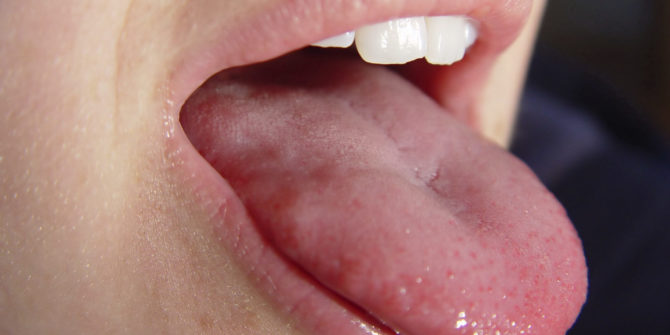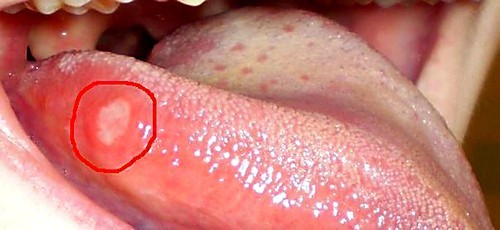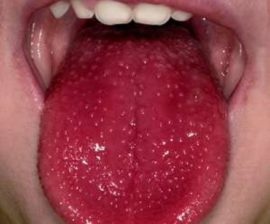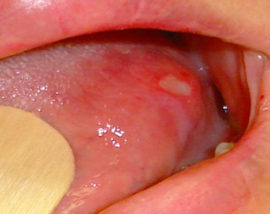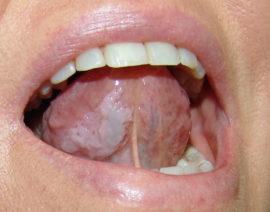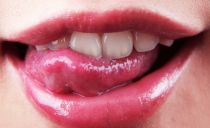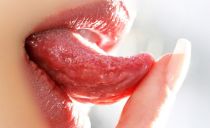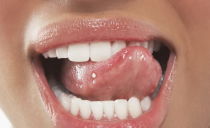The reasons for the appearance of red, white, dark, brown and "bald" spots on the tongue
Language is needed to recognize the taste of food, but, in addition, it is a kind of indicator of human health. Any changes on its surface signal problems in the body.. For example, red spots on the tongue in an adult or a child can appear due to the development of stomatitis, scarlet fever, gall bladder disease, intestines, impaired functioning of the heart, liver or kidneys.
Content
What may be changes in the language
Every morning and evening, after brushing your teeth, you must examine the oral cavity for pathological changes. The procedure, which takes one to two minutes, helps to avoid serious diseases. If a red spot appears on the tongue, it may indicate the development of an allergic reaction, internal or local infectious pathology. With such a symptom, you should consult a doctor.
The tongue of a healthy person should be uniformly pink in color, without changing the relief, moist, clean, not increased in size, painless, moderately sensitive. Pathological changes can be very diverse - from simple redness to ulceration. Here are the main ones:
- neoplasms;
- itching
- plaque;
- color change;
- sores;
- dashes;
- spots of various colors;
- sores;
- plaques.
It must be remembered that many changes in the language appear for serious reasons and may not be noticeable at first. Some, such as plaque or discoloration, may not cause a person discomfort, but this is not a reason to let the situation go by its own accord. The most common problem is spots.
Types of spots on the tongue and the reasons for their appearance
Spots can be of different colors: red, white, yellow, pink, brown and even black. The localization of spots also varies widely: at the tip, at the root, under the tongue or on the sides. Even the relief of the formations may differ from the relief of healthy tissues, which is associated with atrophy of the taste buds.
There may be several or just one spots. They are large and small, round and dotted. It is important to remember that any spots on the tongue speak of problems in the body. All of them are a deviation from the norm and necessarily require a doctor’s diagnosis.
Why red spots appear on the tongue
The tongue may become reddish for the following reasons:
- A long-lasting red spot or blister can indicate such a terrible disease as cancer. Therefore, if it is detected, you should immediately seek medical help.
-
Another reason for the appearance of red spots in the tongue is scarlet fever. Most often, children are affected by this disease. In the early stages of the disease, spots are surrounded by bubbles, when they burst, small sores form in their place.
- Another terrible disease in which red spots are formed on the mucous membrane of the tongue is AIDS. Such spots are localized at the tip or at the root of the organ, usually they protrude above the common surface, reach 7–8 mm in width and are covered with a pale gray coating.Lymph nodes with such a disease are always enlarged.
-
Stomatitis is far from the last among the causes of red spots. Most often, dental red spots are located on the root of the tongue, sometimes they are only surrounded by a red halo, inside they are covered with a white coating.
- If red dots and a white coating appear on the tongue, this is the so-called geographical language. Such a disease is often found in children and pregnant women.
- Hemorrhages can also cause spotting. However, they are usually accompanied by the appearance of red dots on the tip of the tongue, and not full spots. Hemorrhage may indicate a disease such as mononucleosis.
- The mucous membrane of the taste organ may stain after eating food with dyes.
- Allergic reaction.
- Mechanical or chemical damage (burns, injuries).
Brown spots on the tongue
The reasons why brown spots may appear on the tongue are few:
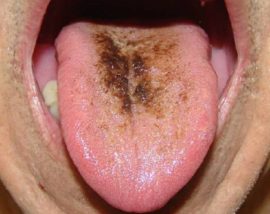 Smoking. This bad habit contributes to the formation of an unaesthetic brown dark coating on the mucous membranes of the mouth and teeth.
Smoking. This bad habit contributes to the formation of an unaesthetic brown dark coating on the mucous membranes of the mouth and teeth.- Eating with dyes, chocolate, a lot of tea or coffee gives a spotty effect.
- The light brown spot indicates problems with joints or diseases of the upper respiratory tract.
- Brown spots with a yellow tint indicate dependence on alcohol, lung and bronchial diseases, as well as drug intoxication.
A dark spot on the tongue is an alarming sign. Thus, the body reflects problems with the gastrointestinal tract, "speaks" of diseases of the kidneys and liver, and malfunction of the gall bladder. If a dark spot is detected, you need to undergo a comprehensive examination in the clinic, identify the cause of the disease and eliminate it.
Red spots and dots on the tongue with a white coating
In both adults and children, red spots on the tongue can appear in tandem with a white coating. Red spots with a plaque appear on the tongue against the background of such pathologies:
- Constipation. Prolonged constipation causes problems with the intestines, which, in turn, affects the entire body and can lead to the appearance of reddened circles on the tongue.
- Poisoning. Such an ailment can cause the appearance of small red dots and plaque in the language.
- Lack of vitamins and nutrients. With vitamin deficiency, the color of the surface of the tongue often changes to pale into small specks. To spotting, weakness, lethargy, pallor of the skin are added.
- Kidney dysfunction. Rounded pink spots form on the tongue.
- Inflammation. Burning, pain, irritation and hypersensitivity to hot and cold can be added to the redness of the organ of taste.
The tongue is covered with a white coating with many diseases. Even a common cold, poor nutrition, or improperly selected medication can lead to plaque formation in the oral cavity.
The causes of the "bald" language
“Bald” spots on the tongue indicate atrophy of the taste buds. With this pathology, some parts of the tongue become completely smooth, as if polished, and acquire a pinkish or bright red color.
Causes of pathology:
- Burns that quickly pass, and the "bald spot" is again overgrown with papillae. A burn is always accompanied by a burning sensation.
- Lack of vitamins and nutrients: B1, B2, B12, PP, proteins.
- Chronic malnutrition
- Anemia.
- Smoking.
- Infections
- Excessive alcohol consumption.
- Dehydration.
Redness of the entire surface of the tongue and its “baldness” often causes chemotherapy. Smooth pink spots appear with psoriasis.
Other pathologies
Black, blue, green, yellow spots and plaques on the tongue are not found as often as those listed above. What do they mean:
- Black spots occur when a fungal infection occurs or during iron oxidation - with piercing.
-
Yellow is a common symptom of jaundice. With this disease, the skin of the body also acquires a yellow tint.
- Green - can be both a symptom of candidiasis (fungal infection), and the result of smoking, mucosal damage or oxidation of the piercing.
- Blue - are often the messengers of more serious pathologies, such as cancer or pneumonia. The tongue is blue with sepsis, bronchial asthma, all kinds of heart defects or with poisoning. Most often, the cause of the appearance of blue spots in the tongue is a problem in the functioning of the human respiratory system.
- Formations in the form of plaques appear on the mucous membranes with leukoplakia due to too rapid growth of benign cells.
Why do spots appear on the tongue of a child
Dots and dots on the child’s tongue can consist of bacteria and white blood cells that died during the inflammatory process, particles of exfoliated epithelium, food debris. Also, the formation of benign and malignant neoplasms can become the reason for a partial change in the color of the organ of taste.
White circles most often appear on the tongues of infants. The surface of the mucous membrane is covered with curd coating or loose specks, which mean the development of a fungal infection - thrush. This disease manifests itself in babies because of their fragile immunity in tandem with infection through a licked mother who has had candidiasis, a dummy, dirty hands, and kisses.
The surface of the mucosa under the plaque is ulcerated, so when you try to remove his tongue starts to hurt. Do not try to clean the tongue of the crumbs from deposits, it is better to resort to processing the mucosa with soda solution.
Yellow spots at the root of the tongue may indicate poor functioning of the baby's digestive system. Typically, diseases of the gastrointestinal tract are accompanied by the appearance of bad breath, stool disturbance, pain in the abdomen and vomiting are possible.
Any dark spots on the baby’s tongue are harmless, since in most cases they arise as a result of staining of the mucous membrane with food. However, if the strange color does not disappear for a long time, you need to urgently consult a pediatrician.
“Bald” areas appear in children's language for the same reason as in adults - due to atrophy of the taste buds. Most often, such a pathology develops with a burn of hot food, traumatic injury, inflammatory diseases. It is not treatable and does not affect the health of the child.
Which doctor should I go to
Few people know which specialist should be contacted if the tongue is stained. In fact, a whole group of doctors can help establish the cause of the disease and get rid of it: a dermatovenerologist, ENT doctor, surgeon, dentist, pulmonologist, gastroenterologist and others. First of all, the patient should visit a therapist or dentist, who, if necessary, will refer him to a narrower specialist.
Any pathology, whether it be small red dots or the redness of the entire surface of the tongue, requires the timely consultation of a competent doctor.
Treatment
How to treat various pathological conditions, the doctor will tell. The most difficult thing is to get an appointment with the right specialist and determine the problem, because the treatment will be aimed not so much at eliminating the external defect as at stopping the internal disease.
Therapy of some diseases can take only a few days, others - months and even years. The duration of treatment depends not only on the type of disease, but also on the degree of its neglect. That is why doctors recommend closely monitoring their health and not delay visiting a medical institution, even if the pathology seems insignificant. Do not ignore even a slight redness.
Prevention recommendations
Many health problems can be avoided by doing the following:
- Stop smoking and excessive drinking.
- Do not start the disease.
- Pay due attention to oral and dental hygiene.
- Be sure to visit the dentist at least twice a year.
- Do not self-medicate.

